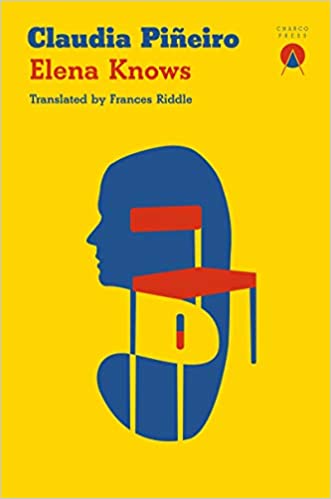Elena knows that “Even if she uses all the tricks in the book, she won’t be able to uncover the truth [about her daughter’s death] unless she recruits another body to help her. A different body that can act in her place. That can investigate, ask questions, walk, look directly into people’s eyes. A body that will obey [her] orders. Not her own body.”
 Suffering from a debilitating illness which limits her movement, Elena, an Argentinian mother in her sixties, has decided she will need help in resolving the death of her daughter Rita, assumed by police and investigators to have been a suicide. Found hanging from the belfry of her local church while a service was in progress, daughter Rita, a middle-aged teacher at the local Catholic school, was Elena’s primary caregiver, though they argued constantly. Rita believed all sorts of superstitions and was somewhat romantic, but she was a devout church goer. Her mother Elena, by contrast, has always been far more pragmatic, not sure whether she believes or has any faith at all, though she does observe the holidays. In an argument with the local priest over whether Rita committed an “aberrant act” by committing suicide, Elena goes so far as to tell the priest that his own “appropriating the word of God is the greatest act of pure arrogance,” and that he has no right to take away her right to decide how to behave or how [she] lives her life. Or how [she or her daughter] dies.” She “knows” that Rita did not kill herself – because it was raining, and Rita was so afraid of lightning that she never even went outside if it rained.
Suffering from a debilitating illness which limits her movement, Elena, an Argentinian mother in her sixties, has decided she will need help in resolving the death of her daughter Rita, assumed by police and investigators to have been a suicide. Found hanging from the belfry of her local church while a service was in progress, daughter Rita, a middle-aged teacher at the local Catholic school, was Elena’s primary caregiver, though they argued constantly. Rita believed all sorts of superstitions and was somewhat romantic, but she was a devout church goer. Her mother Elena, by contrast, has always been far more pragmatic, not sure whether she believes or has any faith at all, though she does observe the holidays. In an argument with the local priest over whether Rita committed an “aberrant act” by committing suicide, Elena goes so far as to tell the priest that his own “appropriating the word of God is the greatest act of pure arrogance,” and that he has no right to take away her right to decide how to behave or how [she] lives her life. Or how [she or her daughter] dies.” She “knows” that Rita did not kill herself – because it was raining, and Rita was so afraid of lightning that she never even went outside if it rained.

Claudia Piñeiro, winner of the Premio Femenino Singular, and Premio Clarin for her work as a novelist.
Argentinian author Claudia Piñeiro, a highly successful author in her own country who has also published four previous “mystery” novels in the U.S., is a careful observer of the social scene in Argentina, providing much information about contemporary life there in the early 2000s, when these “mystery novels” were originally published there. With this novel, which is also described as a “mystery novel,” she writes a far more character-based novel than what I have seen in her previous novels. Here the character of Elena, a particularly iconoclastic and independent thinker and actor, becomes the key to solving the “mystery” of daughter Rita’s death and unlocking the hidden lives of Elena and Rita, including many of the issues which led to the constant arguments between this mother and daughter.
Marshalling all her energy to pursue what she considers the incorrect cause of death – suicide, rather than murder – Elena will stop at nothing as she begins her own investigation, ignoring the conclusions of the police and the church, and challenging both priests and police officers. At the same time, as she does her own investigation, she brings up a long-ago peripheral case in which she and Rita were on opposite sides of the question of abortion as it related to one of their acquaintances. Elena was in favor of the mother’s right to choose, while Rita believed in the absolute sanctity of life. As she heads by train to central Buenos Aires to talk with the woman whose desire for an abortion twenty years ago might be a key to helping her in her current situation, Elena fears the woman will not remember who she is but hopes she will help her. As she heads toward the house where she thinks she will find this woman from twenty years ago, she sees the black and white tiles of the pavement which have always signaled the “abortionist’s house” for her. Her daughter Rita always refused to walk on those tiles, and she herself always accompanied her daughter on the opposite side of the street so Rita would not have to walk alone there.

Rita saved her money to buy a glass sea lion filled with special liquid, like that here. If it turned pink it would be a rainy day. If blue, it would be sunny.
The narrative, which takes place during a single day, gradually includes Elena’s thoughts from the past, including her relationship with her husband and his attitudes toward the church and its policies. A porter at the Catholic school, he was also a theology teacher there, believing deeply in the church and its teachings, while Elena paid only lip service to them. This gave daughter Rita two different points of view to observe while she herself tried to remain within the church’s good graces – the deeply felt beliefs of her father, the more rational behavior of her mother, and her own fears of making a mistake. It is this fear which caused her to resort to superstition, just in case that worked, too – refusing to go outside in the rain to avoid being hit by lightning, refusing to walk on black and white paving stones, and even saving her money to buy a glass sea lion filled with a chemical which turned pink if it was expected to rain, and blue if it would be sunny. A kind person, she also considered a handicapped young man to be her boyfriend, though her mother was repulsed and rejected this idea. All the churchly conflicts experienced by Elena, the contrasts with her husband, and the confusions of Rita, highlight Elena’s inability to share who she really is – and to learn from others.

The train to Buenos Aires, where much of the action takes place, was difficult for Elena to negotiate due to her illness.
A new series of medical tests and new information regarding Elena’s illness lead to the climax, and as the beliefs which underlie the lives of each person help, or clearly do not help, them deal with the “meaning” of the tests as they are personally affected by these new results, the death of Rita takes on new significance. Each character, including Isabel, the woman from the past that Elena has sought out in the city, has a reaction to the news of the testing based on her own past history, and each hopes to be able to deal with it successfully in some way. The answer for Elena arrives unexpectedly, eventually arising, not from any book or priest or prayer or source of advice. Instead, the unexpected arrival of a being guaranteed to survive and win any argument, one who is never wrong, and one who will never talk back, gives tomorrow a whole new look. Facing the future may not be so bad after all.
ALSO by Piñiero: ALL YOURS, BETTY BOO, A CRACK IN THE WALL. THURSDAY NIGHT WIDOWS
Photos. The author’s photo is by Ricardo Ceppi/Getty Images, and it appears on https://www.theguardian.com
Rita was afraid to walk on the black and white paving stones outside a women’s center, even after she was an adult. https://www.pinterest.com
Rita enjoyed a weather indicator in the shape of a sea lion, similar to the heart-shaped one here. On a rainy day, the liquid would turn pink. On a sunny day, it would be blue. https://www.etsy.com
The train to Buenos Aires, where much of the action takes place, was difficult for Elena to negotiate due to her illness. https://www.alamy.com

